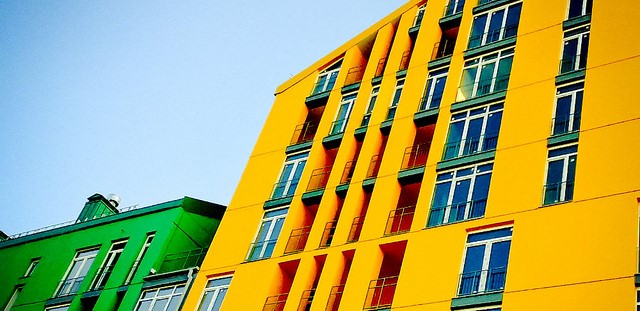Comfort Town is an overly colorful city within a city that promises its inhabitants ‘the real European experience’. In reality the fenced off neighborhood and its alleged 5000 happy families achieve the direct opposite of this goal. They reveal the misinterpretation of a European Union that seems both incredibly close and very far away.
What is it that supposedly makes this little oasis on the eastern bank of the Dnepr so European? A long description on the website of the residential complex crowns the non-functional red windmill in front of a bright yellow flat as the symbol of the European conception according to which the town was build. Viktor, a middle-aged resident enjoying the afternoon in the park, chose to move to Comfort Town because “it’s a residential complex of a closed type and of a European type”. A more profound explanation of its European’ character can be found among the many pictures, stories and interviews featured on the website. Safety, color, an easy life and child friendly utilities seem to be the most dominant elements. Olena Yermakova, a Ukrainian student at the College of Europe in Warsaw provides us with a more straightforward answer: “The Ukrainian perspective of ‘European’ comprises that which is not Soviet”. What makes Europe so desirable is not something concrete and tangible, it is determined by its contrast with the relics of a very recent past. Moving away from modern housing into the realm of political considerations, this includes ideas of democratic values, economic prosperity and progressive values.
These strong, often dichotomous perceptions of the EU reached their height during the Revolution of Dignity on the Maidan Square in 2014. The organizers of the protest utilized the European flag as a symbol of freedom and democratic liberty as opposed to the semi-authoritarian rule of Yanukovych. By contrast, in his ‘Ukraine Diaries’[1] Andrej Kurkov explains how at the same time the anti-European Ukrainian Choice movement managed to persuade many Ukrainians that closer association with the European Union would lead to a universal conversion to homosexuality. Where the last claim is not difficult to debunk, the former seems more deeply rooted in both the convictions of many young Ukrainians as well as in the external communication strategy of the European Union itself. Notwithstanding the political and economic achievements of decades of European integration, to declare the project as an ultimate democratic success seems somehow premature. With record-low electoral participation, what many see as democratic back sliding in Poland and Hungary and increasing dissatisfaction with the unfairly distributed advantages brought about by European integration, it seems there is still quite some trouble in ‘paradise’.
Democratic disillusion
One could ask why defining a somewhat overly glorified goal to strive for should be criticized. The fact that it can motivate an otherwise politically less active community to work together to change the status-quo can only be applauded. The danger lies in the disillusion that follows the confrontation with a reality that will never be able to live up to the ideal that inspired it. The Russian poet and dissident Joseph Brodsky accurately describes a similar quick succession feeling of high expectations and consequent disillusion among dissidents in the USSR: “Hopelessly cut off from the rest of the world, they thought that at least that world was like themselves; now they know that it is like the others, only better dressed”[2]. Even though the context might be different, there is an increasing risk that the young Ukrainians who turned their hopeful gaze to the West will cultivate a similar feeling of disillusion with the pace and depth of the European project.
The mutual idea of a somehow democratically superior European Union furthermore obstructs the lessons the European Union can learn from Ukraine. A practical and slightly ironic example of this is provided by Prof. Yaroslav Hrytsak from the Ukrainian Catholic University of Lviv, who explains that the Revolution has created an unprecedented level of political participation among the young Ukrainian population. In the process of protesting in favor of the European model of democracy they have, at least in terms of participation, easily surpassed their peers in that very same European Union.
It is hard to imagine Comfort Town in Amsterdam, Paris or Berlin; not because the people in these cities categorically despise color, but because of an increasing dissatisfaction with anything associated with ‘the European experience’. Comfort Town nonetheless has more in common with the European Union than meets the eye. Both started out in a relatively open and inclusive manner and ended up as communities fenced off from their neighbors. Both promise a set of European values that in reality rarely live up to the ideals that inspired them. This should not dissuade those living in these two communities to keep on striving for this European ideal. It should make us aware that its realization will require more than buying a house or signing an association agreement.
[1] Kurkov, Andrey. Ukraine Diaries: Dispatches from Kiev. Translated by Sam Taylor. Random House UK, 2015.
[2] Brodsky, Joseph. Less Than One: Selected Essays. 4.1.1987 edition. New York: Farrar, Straus and Giroux, 1987.

